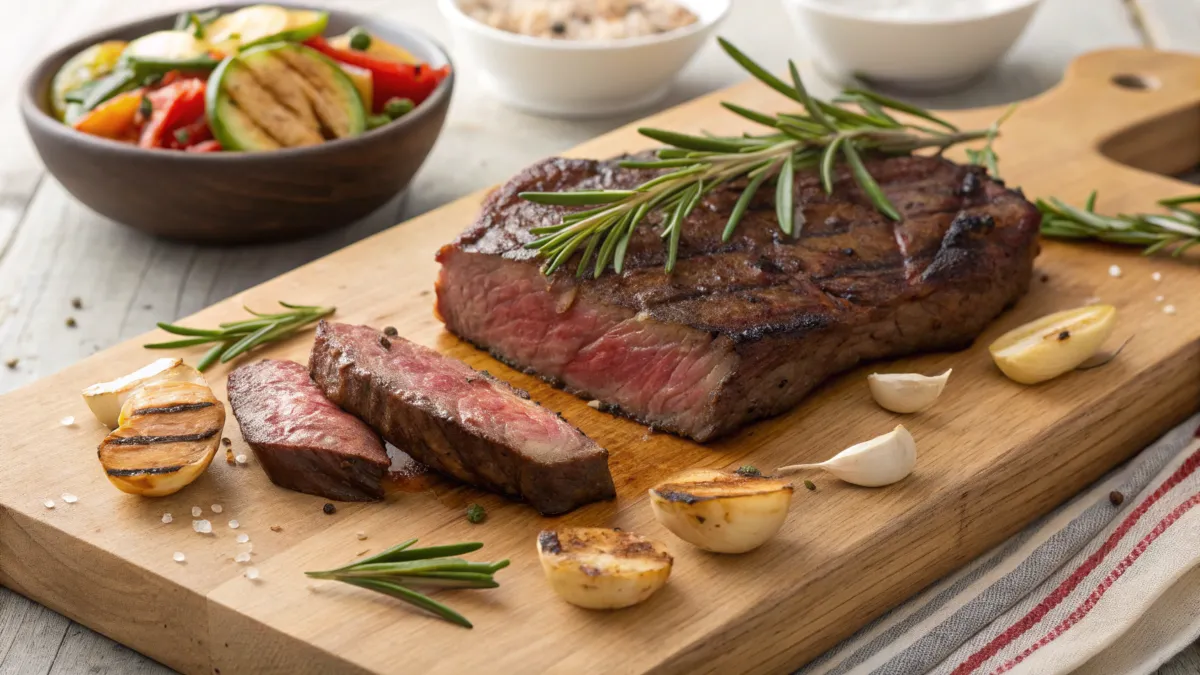The beef loin flat iron steak label might seem like just a piece of packaging, but it holds valuable insights. Understanding this label can help you make informed choices at the grocery store or butcher shop. From learning what makes this cut unique to decoding the information on the label, you’ll uncover everything you need to know. In this guide, we’ll explore its characteristics, cooking techniques, benefits, and much more. Let’s dive right in!
Table of Contents
Understanding Beef Loin Flat Iron Steak
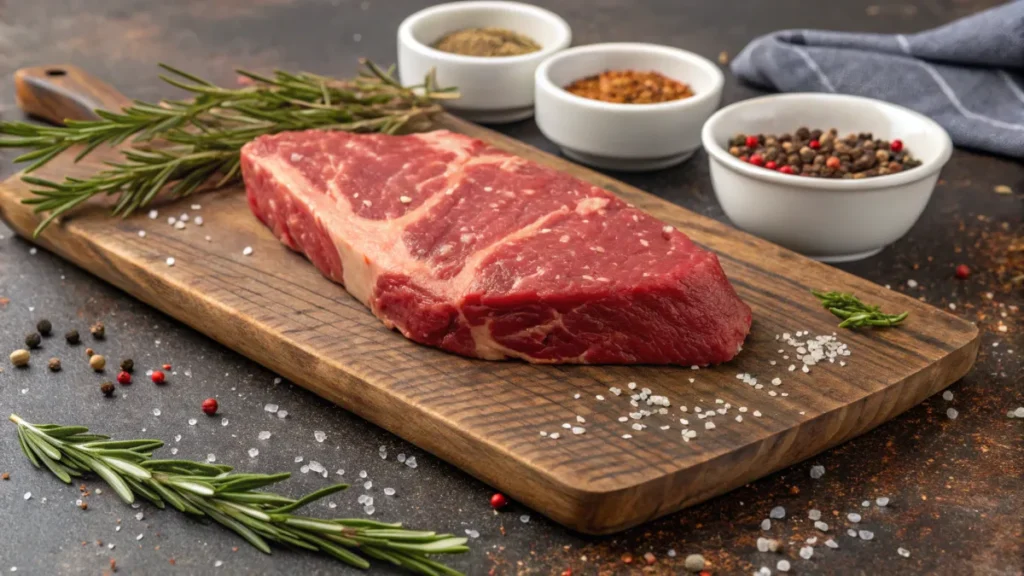
What Is Beef Loin Flat Iron Steak?
Beef loin flat iron steak is a tender and flavorful cut of beef that comes from the shoulder area, specifically the chuck. It’s known for its rich marbling and tender texture, which make it perfect for a variety of dishes. Sometimes called “top blade steak,” it has gained popularity among chefs and home cooks for being both affordable and delicious.
Unlike pricier cuts like ribeye or filet mignon, the flat iron steak offers exceptional taste without breaking the bank. Its natural tenderness and versatility make it a go-to choice for grilling, pan-searing, or broiling.
Characteristics of Beef Loin Flat Iron Steak
- Texture and Flavor:
Flat iron steak is highly prized for its buttery texture and deep beefy flavor. Its marbling adds to its juiciness and ensures a tender bite every time. Unlike tougher cuts, it requires minimal effort to cook perfectly. - Popular Uses in Cooking:
This steak is a crowd-pleaser whether it’s served as a main dish or used in recipes like stir-fries, tacos, or salads. Its ability to soak up marinades makes it a favorite for bold, flavorful dishes.
Understanding the unique qualities of beef loin flat iron steak helps you appreciate why it’s a staple in kitchens worldwide. It’s a cut that combines flavor, tenderness, and versatility all in one.
Decoding the Label
What Does ‘Beef Loin Flat Iron Steak’ Label Mean?
The beef loin flat iron steak label offers vital details about the cut of meat you’re purchasing. It specifies the steak’s origin from the shoulder area, emphasizing its unique qualities, such as tenderness and marbling. The label ensures transparency, helping buyers understand exactly what they’re getting.
Moreover, USDA labeling standards require this information to be clear and accurate. This helps you compare cuts easily and make informed choices. By paying attention to the label, you can pick the best steak for your cooking needs.
Key Information on the Label
- Nutritional Facts:
Labels often include the calorie count, protein content, and fat percentage of the steak. This helps consumers assess whether the cut fits their dietary goals. For example, beef loin flat iron steak is relatively lean compared to fattier cuts like ribeye. - Packaging and Grading Details:
USDA grading (e.g., Prime, Choice, Select) indicates the quality and marbling of the steak. Prime is the highest grade and often boasts the most marbling, while Choice is still tender but slightly leaner.
Understanding these details on the beef loin flat iron steak label ensures you can choose the best cut for your budget and recipe.
Cooking Beef Loin Flat Iron Steak
Preparing the Steak
Preparing beef loin flat iron steak correctly can elevate your meal. Start by patting the steak dry with a paper towel to ensure a good sear. Then, season it generously with salt, pepper, and any additional spices you prefer. If you’re using a marinade, let the steak rest in it for at least 30 minutes to absorb the flavors.
Proper preparation not only enhances the taste but also ensures the steak cooks evenly. Always let it come to room temperature before cooking for the best results.
Best Cooking Techniques
- Grilling:
Grilling is one of the best ways to cook beef loin flat iron steak. Preheat your grill to medium-high heat and cook the steak for about 3–4 minutes per side for medium-rare. The charred exterior adds depth to its flavor. - Pan-Searing:
A hot cast-iron skillet is ideal for searing flat iron steak. Add a touch of oil and cook the steak over high heat for 2–3 minutes per side. Finish with butter and herbs for an indulgent touch. - Broiling:
Broiling is a convenient option for indoor cooking. Place the steak on a broiler pan and cook for 4–5 minutes on each side. Keep an eye on it to avoid overcooking.
Cooking beef loin flat iron steak is quick and straightforward, making it perfect for weeknight dinners or special occasions. Pair it with roasted vegetables or a fresh salad for a balanced meal.
Recipes Featuring Beef Loin Flat Iron Steak
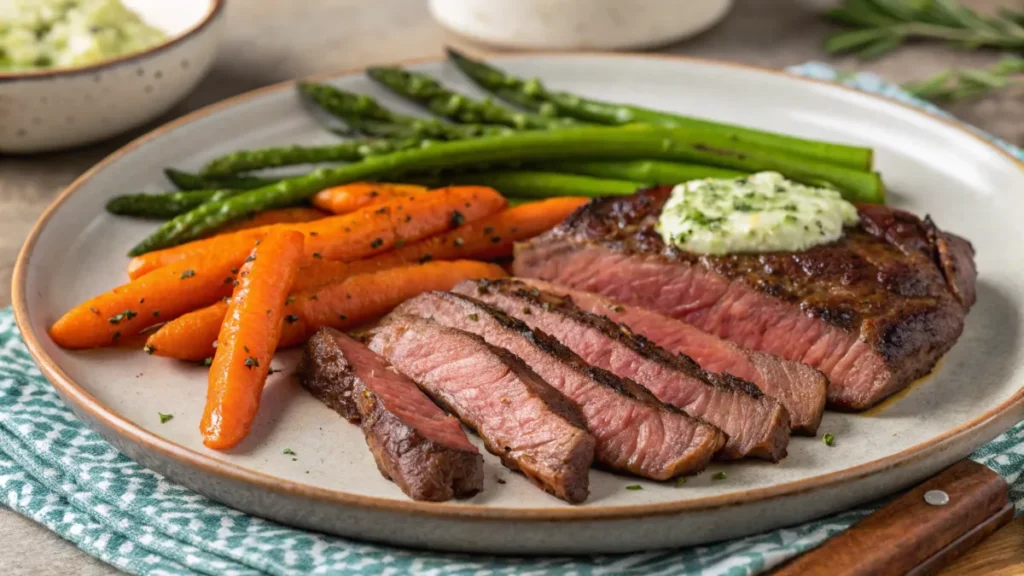
Classic Flat Iron Steak with Herb Butter
One of the best ways to enjoy beef loin flat iron steak is with a simple herb butter. Start by seasoning the steak with salt and pepper. Sear it in a hot skillet for 3–4 minutes per side. While the steak rests, mix softened butter with garlic, parsley, and thyme. Spread the butter over the steak just before serving for a rich, flavorful finish.
This dish pairs perfectly with roasted potatoes or steamed asparagus, making it ideal for a hearty dinner.
Flat Iron Steak Tacos
For a fun twist, use beef loin flat iron steak in tacos. Marinate thin slices of the steak in lime juice, garlic, and cumin. Cook them on high heat for a few minutes, then serve in warm tortillas. Add toppings like diced onions, cilantro, and salsa for a fresh and zesty flavor.
Tacos are a great way to highlight the steak’s bold taste while keeping the meal light and easy to prepare.
Benefits of Flat Iron Steak
Nutritional Advantages
Flat iron steak isn’t just tasty it’s packed with nutrients. A serving of beef loin flat iron steak offers high protein levels to support muscle growth. It’s also rich in iron and zinc, essential for energy and a healthy immune system. Despite its flavor, it’s a relatively lean cut compared to others, making it a smart choice for balanced diets.
When paired with healthy sides like vegetables or whole grains, flat iron steak can be part of a nutritious, satisfying meal.
Cost and Accessibility
One of the biggest perks of beef loin flat iron steak is its affordability. While it delivers the tenderness and flavor of premium cuts, it’s much more budget-friendly. This makes it an excellent option for families or those wanting gourmet meals without spending a fortune.
You can find flat iron steak at most grocery stores or butcher shops, ensuring it’s readily available for your next recipe.
For more delicious ideas, check out Charmed Recipes for classic beef dishes that pair perfectly with flat iron steak.
Frequently Asked Questions About Flat Iron Steak
What’s the Difference Between Flat Iron Steak and Flank Steak?
Many people confuse flat iron steak with flank steak because both are thin cuts ideal for quick cooking. However, they are quite different. Flat iron steak comes from the shoulder (chuck) area, whereas flank steak is from the abdominal muscles. This difference gives flat iron steak its tenderness and fine marbling, while flank steak tends to be leaner and tougher.
If you’re looking for a tender option that’s easy to cook, flat iron steak is the better choice. On the other hand, flank steak is great for recipes where a firmer texture works, like fajitas.
How Long Does Flat Iron Steak Stay Fresh?
The freshness of your steak depends on how it’s stored. When refrigerated at 40°F or below, beef loin flat iron steak typically lasts 3–5 days. If you freeze it, the steak can stay fresh for up to 6 months without losing quality. Always check the beef loin flat iron steak label for the “sell-by” or “use-by” date to ensure safety.
To extend shelf life, store it in airtight packaging or vacuum-seal it to prevent freezer burn.
Is Flat Iron Steak Tender?
Yes, flat iron steak is considered one of the most tender cuts after filet mignon. It’s fine marbling ensures that each bite is juicy and full of flavor. With the right cooking methods like grilling or pan-searing it’s easy to achieve a melt-in-your-mouth texture.
Tips for Selecting the Best Beef Loin Flat Iron Steak
What to Look for When Buying
When shopping for beef loin flat iron steak, there are a few key things to consider:
- Color: Look for a bright red color, which indicates freshness. Avoid steaks with a dull or grayish hue.
- Marbling: Opt for steaks with fine, even marbling. This fat melts during cooking and adds flavor.
- Packaging: Check that the packaging is airtight, with no leaks or tears.
Reading the beef loin flat iron steak label can also provide information about its grade, such as USDA Prime or Choice. These grades help you understand the quality of the meat.
Where to Buy High-Quality Flat Iron Steak
Flat iron steak is widely available at grocery stores, butcher shops, and even online retailers. For the freshest cuts, visit a local butcher who can guide you toward the best options. Some specialty meat markets even offer grass-fed or organic varieties for those seeking premium quality.
Shopping online is another convenient choice. Many reputable websites deliver vacuum-sealed beef loin flat iron steak straight to your door, ensuring freshness and ease.
Storing and Handling Flat Iron Steak
How to Store Raw Flat Iron Steak
Proper storage is crucial for maintaining the quality of your beef loin flat iron steak. To store it in the refrigerator, wrap it tightly in plastic wrap or place it in an airtight container. This prevents exposure to air, which can cause spoilage. The steak can stay fresh for 3–5 days when kept at a consistent temperature below 40°F.
For longer storage, freezing is the best option. Use vacuum-sealed bags or heavy-duty freezer bags to protect the steak from freezer burn. Label the packaging with the date so you can keep track of its freshness. Flat iron steak can last up to six months in the freezer while retaining its flavor and texture.
How to Reheat Without Losing Flavor
When reheating flat iron steak, it’s important to preserve its tenderness. Avoid using high heat, as this can overcook the steak. Instead, reheat it in a low-temperature oven or a skillet with a bit of beef broth. This keeps the meat moist and flavorful.
Microwaving is an option, but it should be done cautiously. Use a lower power setting and cover the steak with a damp paper towel to retain its juices.
Serving Suggestions and Pairings
Best Side Dishes for Flat Iron Steak
Flat iron steak pairs beautifully with a variety of side dishes. Here are a few classic options:
- Roasted Vegetables: Carrots, asparagus, and brussels sprouts bring out the steak’s natural flavors.
- Mashed Potatoes: Creamy mashed potatoes complement the rich texture of beef loin flat iron steak.
- Grain Bowls: Serve the steak over quinoa or wild rice for a healthy, hearty meal.
Flat iron steak pairs wonderfully with classic sides like roasted vegetables or mashed potatoes. Check out Vegetarian Soup Dumplings for inspiration. For a lighter option, a grain bowl with quinoa or wild rice works well.
Sauces to Elevate the Flavor
Adding a sauce can take your steak to the next level. Consider these options:
- Garlic Herb Butter: Simple yet decadent, it melts beautifully over hot steak.
- Red Wine Reduction: This sauce adds a touch of elegance and pairs well with the steak’s rich flavor.
- Chimichurri: A zesty mix of parsley, garlic, and vinegar, perfect for a fresh finish.
These sides and sauces ensure that every bite of your steak is as memorable as the last.
A Comparison of Steak Cuts
Flat Iron Steak vs. Skirt Steak
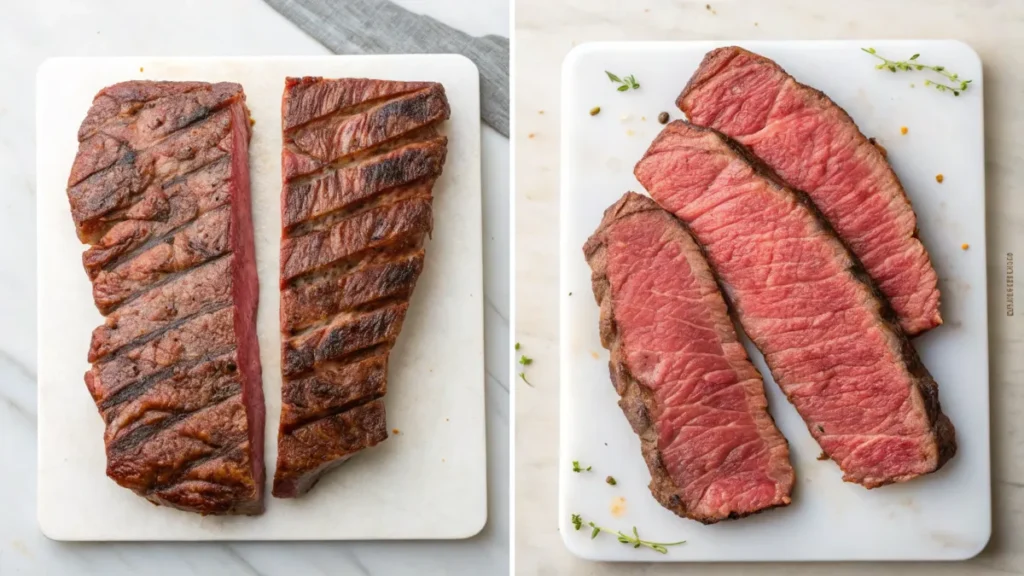
When comparing flat iron steak and skirt steak, their textures and flavors stand out as the key differences. Flat iron steak comes from the shoulder, offering a tender, well-marbled cut. In contrast, skirt steak is taken from the diaphragm and is leaner with a more fibrous texture.
Flat iron steak is better for dishes where tenderness and a buttery mouthfeel are priorities. Meanwhile, skirt steak works well in recipes like fajitas or stir-fries, where the beef can be sliced thinly and cooked quickly. Both cuts are versatile, but flat iron steak often wins for its ease of preparation and juicy flavor.
Flat Iron Steak vs. Ribeye
Ribeye and flat iron steak share similarities in flavor, thanks to their marbling. However, ribeye is fattier and more indulgent, making it a favorite for grilling enthusiasts. On the other hand, flat iron steak offers a balance of tenderness and leanness, with just enough marbling for flavor.
If you’re seeking a more affordable option without compromising on taste, flat iron steak is the way to go. Ribeye is great for special occasions, but flat iron steak shines as a budget-friendly alternative for everyday meals.
Nutritional Comparison of Flat Iron Steak and Other Cuts
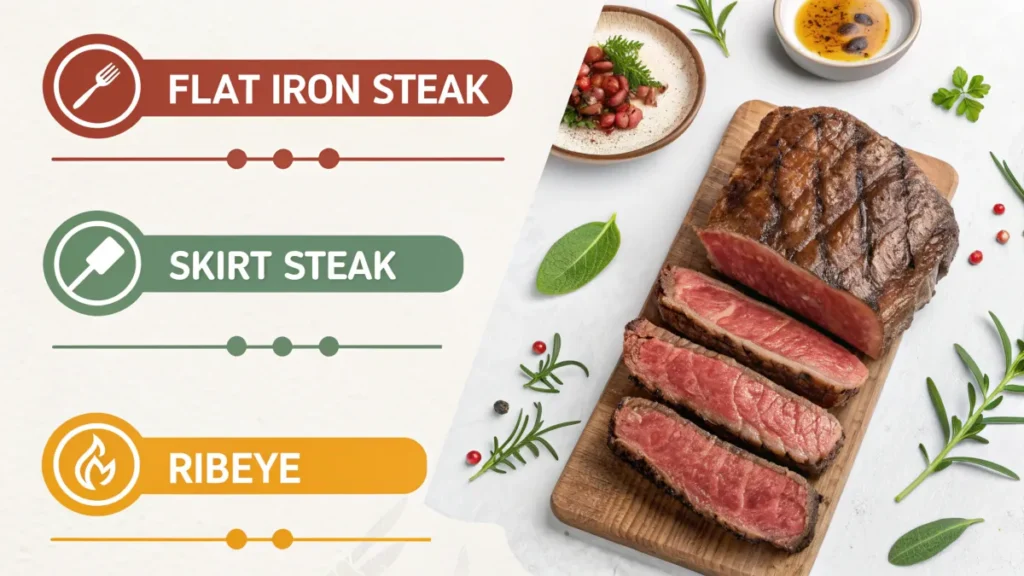
| Nutrient | Flat Iron Steak | Skirt Steak | Ribeye |
|---|---|---|---|
| Protein (per 100g) | 23 g | 21 g | 22 g |
| Fat (per 100g) | 10 g | 12 g | 14 g |
| Calories (per 100g) | 200 kcal | 230 kcal | 290 kcal |
Insights From the Comparison
Flat iron steak offers a balanced nutritional profile, making it a healthier option compared to ribeye. While ribeye is higher in fat and calories, it delivers a richer flavor. Skirt steak is slightly leaner than ribeye but less tender than flat iron steak. Depending on your dietary preferences, each cut has its place in the kitchen.
Conclusion
The beef loin flat iron steak label is more than just a piece of packaging it’s your guide to a delicious and versatile cut of beef. From understanding its unique characteristics to learning how to cook, store, and serve it, flat iron steak proves to be an exceptional choice for any occasion. Its tender texture, rich flavor, and affordability make it a favorite among home cooks and chefs alike.
Whether you’re grilling it for a backyard barbecue or searing it for a quick weeknight dinner, flat iron steak delivers in taste and ease. By following the tips in this guide, you’ll be able to enjoy this cut at its best every time. So, the next time you see a beef loin flat iron steak label, grab it confidently you won’t be disappointed!

